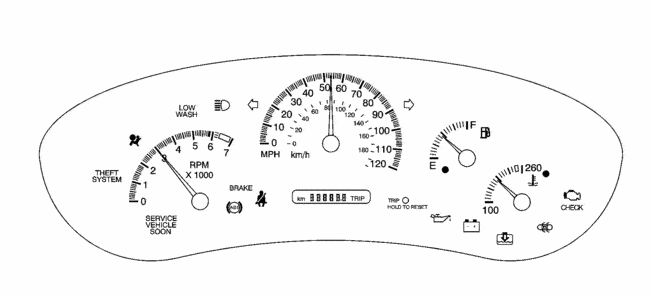 I have some serious instrument cluster problems. All cluster lights come on at one time and cause the gas gauge to go to zero and the cruise controls stops working.
I have some serious instrument cluster problems. All cluster lights come on at one time and cause the gas gauge to go to zero and the cruise controls stops working.
Instrument Cluster Problems
In reviewing what causes some of what is going on here I have come up with 3 things.
- Malfunction in the fuel level sensor circuit
- Lack of communication with PCM
- Lack of communication with BCM
Review the tests and information below to help diagnose your instrument cluster problems.
Instrument Panel Cluster (IPC)
Your instrument panel cluster is designed to let you know at a glance how your vehicle is running. You’ll know how fast you’re going, how much fuel you’re using, and many other things you will need to drive safely and economically.
Your vehicle has this instrument panel cluster, which includes indicator warning lights and gauges that are explained on the following pages.
Instrument Cluster Description and Operation
Instrument Cluster Problems Displays Test
Certain instrument panel cluster (IPC) features are tested when the ignition is turned on in order to verify the features are working properly. The following indicators illuminate briefly at key up unless otherwise noted:
- ABS
- Air bag – flashes 7 times
- Brake system
- Charging system
- Check oil
- Door ajar
- Engine coolant temperature
- Fasten safety belt
- A Low engine coolant level
- Low fuel
- Low washer fluid
- Malfunction Indicator Lamp (MIL)
- Service vehicle soon
- Theft system
Engine Coolant Temperature Gauge
An IPC displays the engine coolant temperature as determined by the PCM. The body control module (BCM) receives a class 2 message from the PCM indicating the engine coolant temperature. The BCM converts the engine coolant temperature into a percent gauge deflection. An IPC receives a message from the BCM via the serial peripheral interface (SPI) indicating the requested gauge position. The engine coolant temperature gauge defaults to 38°C (100°F) or below if:
- A PCM detects a malfunction in the engine coolant temperature sensor circuit.
- The BCM detects a loss of class 2 communications with the PCM.
- An IPC detects a loss of SPI communications with the BCM.
Fuel Gauge
An IPC displays the fuel level as determined by the PCM. The body control module (BCM) receives a class 2 message from the PCM indicating the fuel level percent. The BCM converts the fuel level percent into a percent gauge deflection. An IPC receives a message from the BCM via the serial peripheral interface (SPI) indicating the requested gauge position. The fuel gauge defaults to E (empty) if:
- A PCM detects a malfunction in the fuel level sensor circuit.
- The BCM detects a loss of class 2 communications with the PCM.
- An IPC detects a loss of SPI communications with the BCM.
When the fuel level is less than a pre-determined value, the low fuel indicator illuminates.
Odometer
The IPC contains a season odometer and a trip odometer. Momentarily press the trip/reset switch on the IPC in order to toggle between the season odometer and the trip odometer. In order to reset the trip odometer, press the trip/reset switch for greater than 2 seconds. The IPC calculates the mileage based on the vehicle speed signal circuit from the PCM. The odometer will display ‘error’ if an internal IPC memory failure is detected.
Speedometer
An IPC displays the vehicle speed based on the information from the PCM. The PCM converts the data from the vehicle speed sensor to a 4000 pulses/mile signal. An IPC uses the vehicle speed signal circuit of 4000 pulses/mile from the PCM in order to calculate the vehicle speed. The speedometer defaults to 0 km/h (0 mph) if a malfunction in the vehicle speed signal circuit of 4000 pulses/mile exists or if the BCM sends or receives invalid data with the IPC via serial peripheral interface (SPI).
Tachometer
An IPC displays the engine speed based on information from the PCM. The PCM converts the data from the engine speed sensor to a 2 pulses/engine revolution signal. An IPC uses the engine speed signal circuit of 2 pulses/engine revolution from the PCM in order to calculate the engine speed. The tachometer defaults to 0 rpm if a malfunction in the engine speed signal circuit of 2 pulses/engine revolution exists or if the BCM sends or receives invalid data with the IPC via serial peripheral interface (SPI).
Instrument Cluster Programming and Setup
This device requires no programming or setup.
